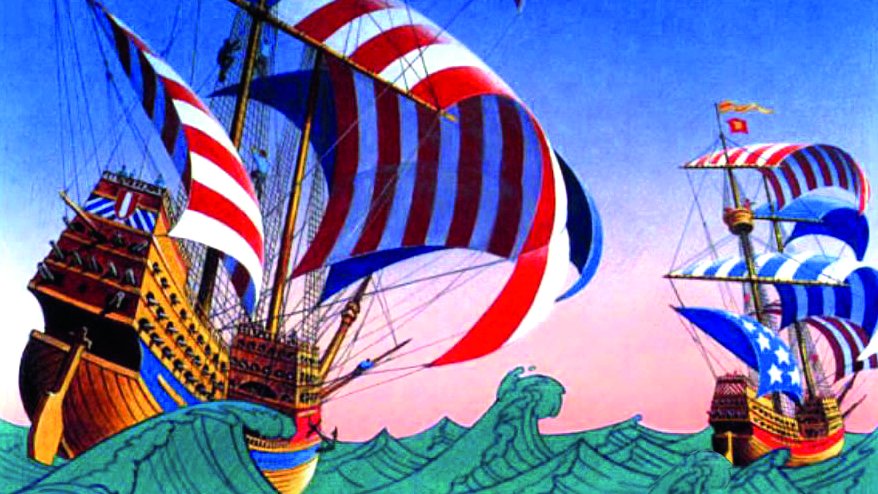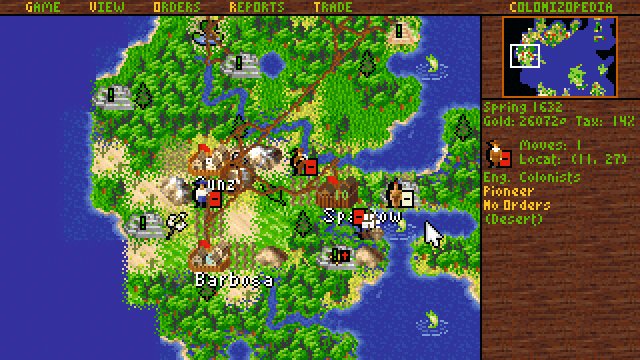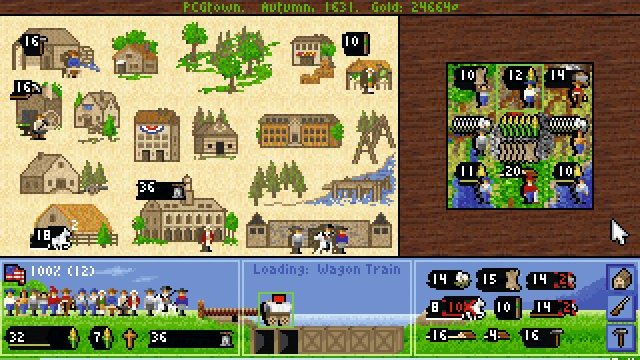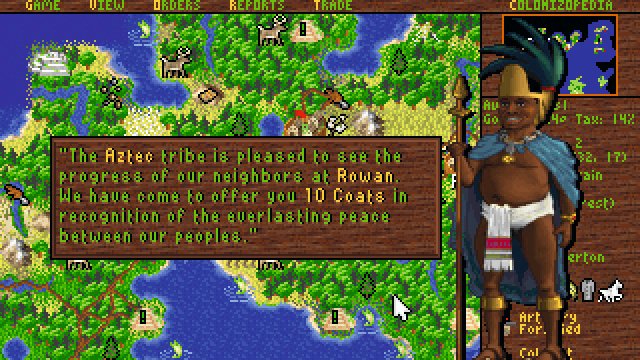Revisiting Colonization, Sid Meier's overlooked resource juggler
Sell, steal, survive.


Reinstall invites you to join us in revisiting PC gaming days gone by. Today, Lorna fights for profits in the challenging Colonization.
Paving over the entirety of the New World may not be an easy task but, with a few hundred years and a copious coin purse, it is possible to become more of a threat to the environment than Jeremy Clarkson. Sid Meier’s Colonization may not now be the most grand looking game but, back in the day, Civilization’s little brother was something of a treat.
Released in 1994 by MicroProse, the now oft-overlooked strategy management game pulled in positive coverage on the Amiga, despite lingering in the shadow of the wider-known Civilization series. Colonization is one of those games that lures you in with the promise of a sedate strategy experience as you begin to colonise the New World—either the actual Americas or a randomly generated map. You build, harvest, manufacture, trade, and bolster rebel sentiment until you can stick two fingers up at the tax-grabbing King, declare independence, and fight for freedom.
It sounds easy, but even now it’s one of those games whose apparent simplicity morphs into you wrangling a nest of vipers inside the belly of an anaconda. By the end you’ll be an overburdened mess, an outcast to your own countrymen, doing more juggling than Penn Jillette.

While it didn’t quite fall slap bang into the “so hard it will shatter your eyeballs if you so much as look at it funny” era of gaming, there is little handholding here. Colonization gives you a few tools and quite happily lets you dig your own grave.
Picking from one of four nationalities is your first order of business, and then it’s off to the New World with only a couple of colonists, 1,000 gold, and a dinky ship. That’s it. Looking back it’s incredibly stingy and unlike other games in its genre there’s no loan or overdraft on offer, no Dodgy Dave’s Ye Olde Pawn Shoppe. You manufacture, you sell, or you nick stuff from other people. If your ship gets sunk and your colonists wiped out by starvation, natives, or other Europeans (probably shouldn’t have laughed at the French when they accused me of sinking their ships) then you’re more stuffed than a Thanksgiving turkey.
The game plays out on a colourful overhead map and thanks to the retro-nostalgia that’s been permeating gaming for years now, the graphics aren’t jarring to return to. They’re bright, cosy, and the resources detailed. Which is good, because you’ll be spending a great deal of time staring blankly at everything as you wonder what the hell to prioritise.
From this map you build colonies, control units, trade with natives or fellow Europeans, and explore. You can also click through to specific colonies for more in-depth management of colonists, buildings, and resources. And that’s where you start to become ensnared. The game is pretty swift in luring you onto the rocks of overspending, stretching your resources too thin, and pissing off the natives.
Keep up to date with the most important stories and the best deals, as picked by the PC Gamer team.

Even from the start, your decisions are crucial. Setting up a colony isn’t just a matter of chucking down a new town, care needs to be taken in weighing up the best location. Do you want to be near that seam of silver, or surrounded by land that could potentially yield a valuable tobacco bonus? It’s something you’ll debate repeatedly throughout the game as you place more colonies.
For an indecisive player like me, it’s torture. I can’t possibly do everything at once but I’ll sure as bloody hell try. Shall I sell this baccy in London or potter around trying to find a native capital with which to trade? Do I buy tools or manufacture them myself? Shall I throw my cargo of rum into the harbour and tell the king to bugger off or accept the latest rise in tax? Do I waste time annoying the French for the sake of it or not?
The more colonies you build and the more people you oversee the trickier it gets, piling more and more on until each turn stretches to infinity and back. Resource and colony management is one of those infernal balancing acts that taxes every gamer who dabbles in strategy waters. Focus too much on one colony or element and the others muddle along, under producing, wasting resources, or falling prey to attack.
It’s easy to let your good intentions slide as other things get in the way. You mean to build a road to that far-flung colony but your pioneer runs out of tools, so you give him some horses and turn him into a scout instead. After ‘accidentally’ plundering numerous Native American burial grounds—the gold… it calls to us—you suddenly remember that lost colony where one guy is slogging away, harvesting endless lumber for a warehouse that was full five years ago. Sorry mate.

The game includes a simplified combat element but it’s basic, uninvolved, and there’s little to nothing you can do to influence the outcome of a scrap, which is a shame. While it never bothered me back then (or now, honestly), it remains Colonization’s most lacking element. However, in this sort of game it’s really only a sprinkle on a cupcake whose good stuff truly lies in its gooey resource-hell heart.
Of course, you aren’t the only one scrabbling to be the big power in the New World. The French, Spanish, and Dutch are also lurking about and, sooner or later, you’ll have to deal with them. One way or another. As for the natives, the worth of taking out a village is nothing compared to what you can get via trade, and since an attack will enrage every village within that nation, leading to trouble, it’s not worth the headache. Especially when they steal back the wagons of looted gold before you can reach safety.
Like other games of its kind, Colonization remains one for players with a hardy gaming constitution—you’re in it for the long haul and there is no such thing as a quick game. Even on the easy setting it’s an eye-melting slog to the end, often only to face the indignity of a crappy score for your herculean efforts.
Back in 1994 Colonization felt like a big game. It was. It even came with an in-game Colonopedia, yielding details on Founding Fathers, terrain, buildings, and more. It seems more compact by today’s standards but there’s absolutely nothing wrong in that—it’s even kind of cosy. It has enough of a challenge and addictive edge to keep me returning and that there’s a dedicated fan community still playing, swapping strategies and comparing scores, is no surprise. It’s a game that’s easy to get into, hard to master, and nigh on impossible to get away from. I’ve tried, believe me.

